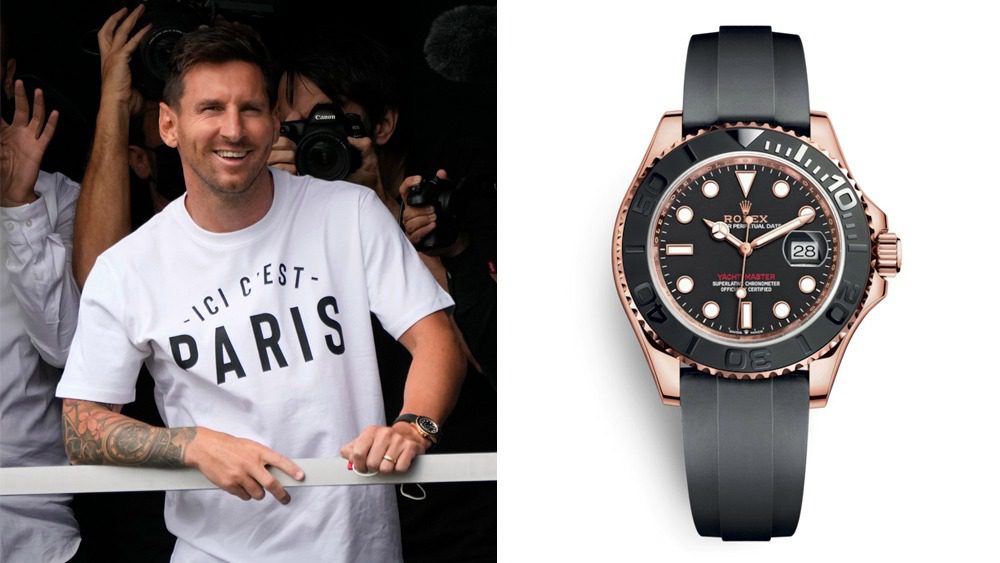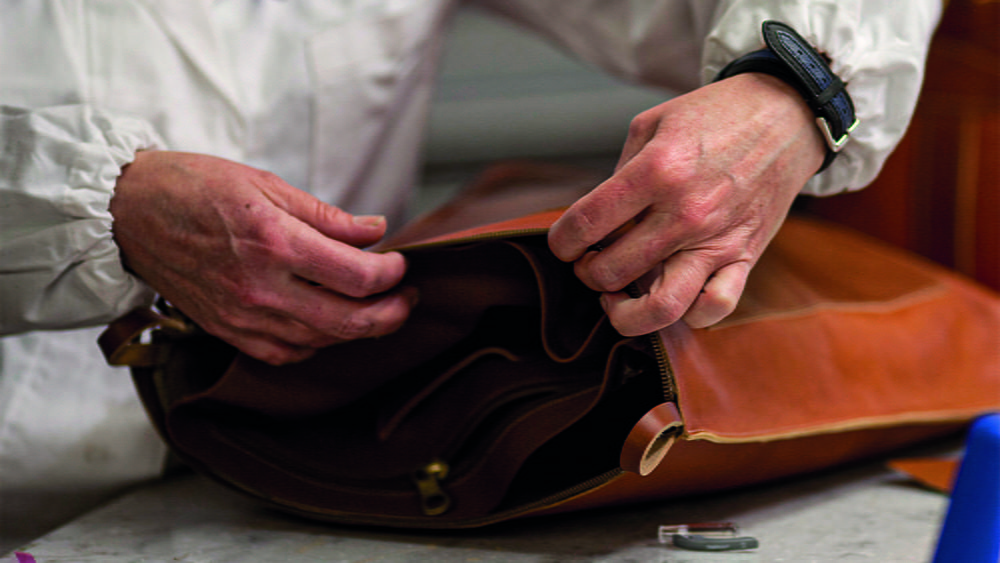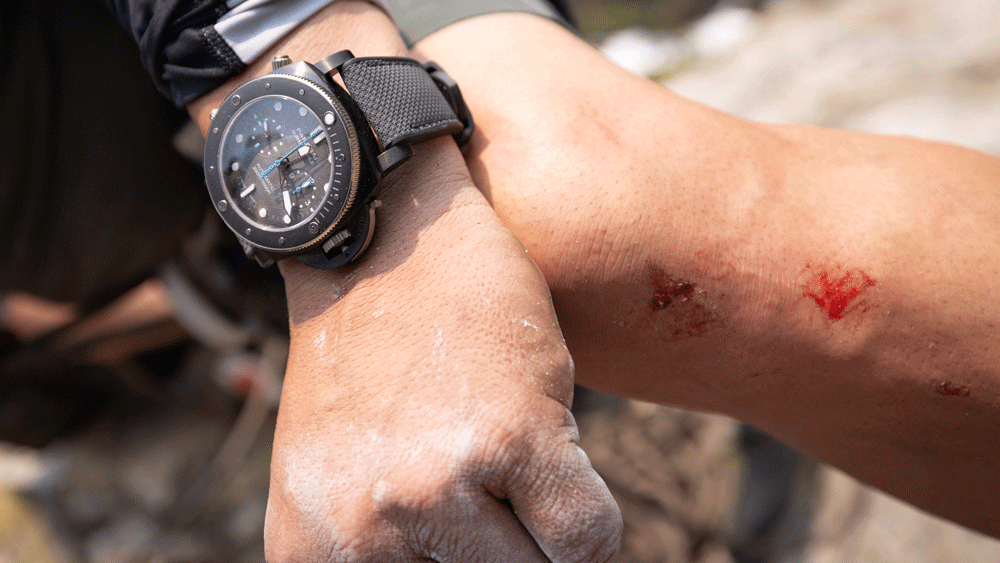
All This for a Watch? Here’s What It’s Like to Go on One of Panerai’s VIP Extreme Watch Experiences
One brave writer went mountain climbing with Jimmy Chin—and has the scars to show for it.
As I peered up at the jagged vertical drop looming 700-feet in the air, my palms began to sweat and the back of my neck burned as I thought to myself, “What the hell have I gotten myself into?”
Months earlier I had agreed to take part in Panerai’s latest extreme excursion tied to a limited-edition watch in an effort to gauge whether the marketing hype and price tags (at $42,000 it’s roughly $20,000 over the retail value of the watch) matched the actual experience. Previous trips have included a free-diving expedition in French Polynesia with the record-setting French free diver Guillaume Néry and a hardcore training experience with the Royal Italian Navy in La Spezia, Italy. (Another with arctic explorer, Mike Horn, to the North Pole has been postponed due to travel restrictions as a result of the pandemic.) In order to be able to purchase the ultra-limited watch, you need to have deep pockets, extensive Panerai purchase history and, most importantly, be willing to participate in the adventure experience. And as I was about to learn, that’s the hardest part.
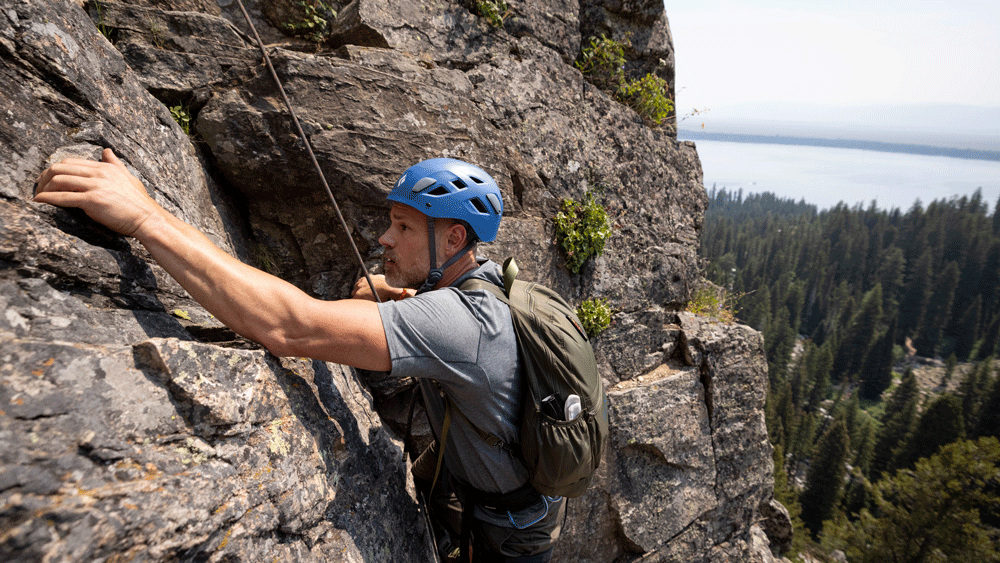
A Panerai client braving the climb.
Dirk Collins
For a little context, my idea of a strenuous workout is running two miles on a treadmill. I don’t have an athletic bone in my body (or so I thought). I would much prefer to be sitting comfortably indoors with a good book than hanging over a cliff to test my limits. And I am terrified of heights. But yet, here I was about to scramble up a mountain in the heart of the Grand Teton National Park without ever having been rock climbing in my life. Not to mention the fact that I was going with one of the best pro-climbers in the world whose claim to fame is hanging off of cliffs at elevations of 3,000 feet while filming his friend Alex Honnold climb Yosemite’s El Capitan without ropes for the Oscar-winning documentary, Free Solo. As far as being out of one’s depth goes, I was off the charts. Nothing like starting from the top, right?
So, back to the mountain. Now that I was actually there looking up at it, I figured I’d give it a go, and as soon as they realize I can’t make it up even 10 feet they’ll give up on me and focus on getting the more athletic people up the mountain. “I’m here to see if the collectors feel this experience is extreme enough for them,” I said to myself. I should have known “giving up” is not even in the vocabulary of people like Chin and his collective of pro-climbers enlisted to lead the excursion.
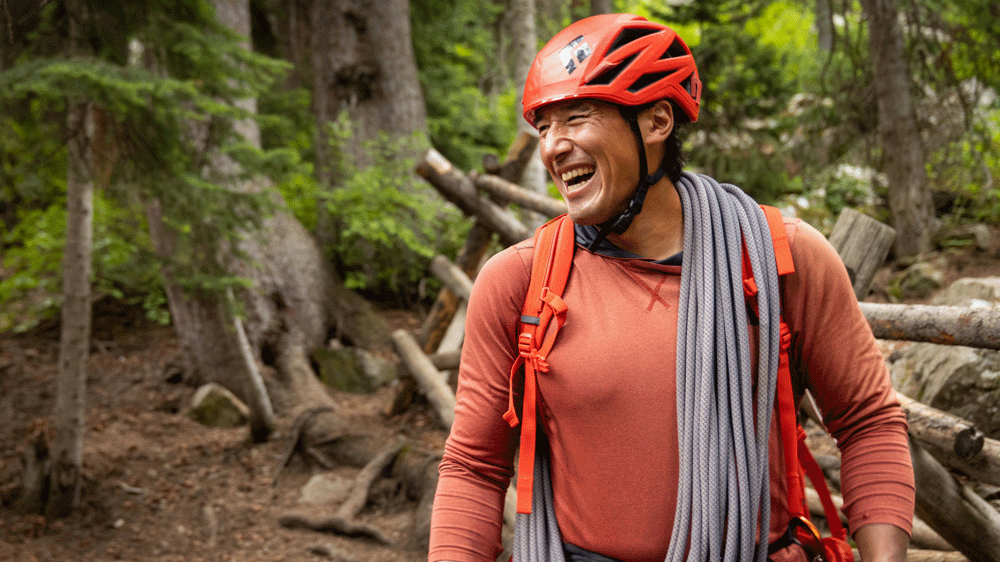
Jimmy Chin
Dirk Collins
When he and Panerai’s North American brand president, Philippe Bonay, repeatedly drove home the message, “We want to push you to your limit,” I somehow took for granted that mantra might mean something wildly different for this crowd. “A big part of my career has been about pushing myself outside of my comfort zone,” Chin told the group. “I’m very calculated about it. I’ve chosen this profession because I’ve found the best version of myself when the stakes are really high.” What ensued was one of the most physically and mentally challenging, but ultimately rewarding, experiences of my life.
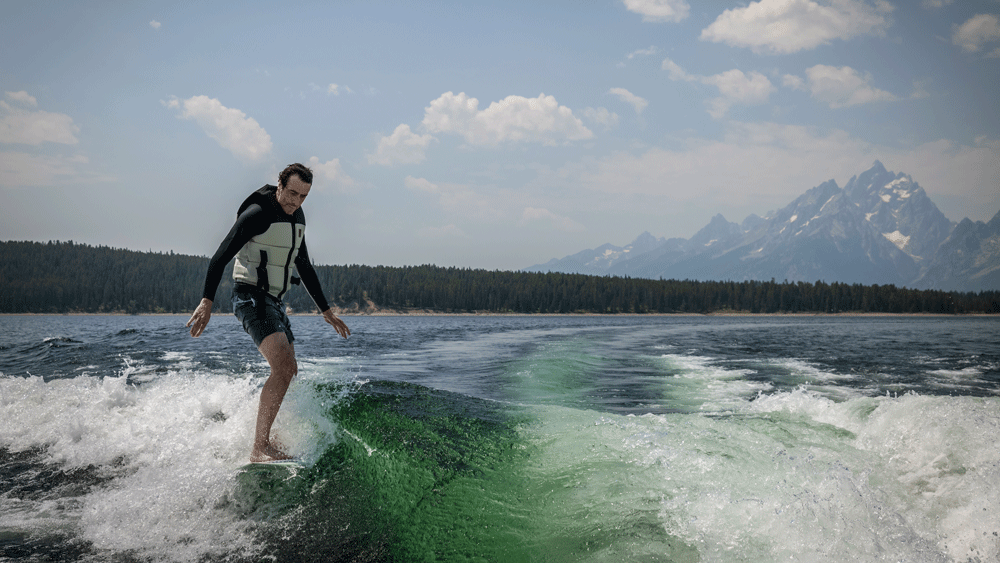
Panerai’s Philippe Bonay wake surfing on Jackson Lake
Britt Mumma
First, we were divided into two groups based on our experience. You can imagine where I ended up. The first day the more experienced group tackled the mountain, and our group was dropped off at Jackson Lake, one of Chin’s favorite local spots in his hometown with glassy pristine water set against a backdrop of mountains with snow-dusted peaks, for an afternoon of wake surfing. It wasn’t easy—only three of the seven guests on our boat were able to stand up on the board. I didn’t make it up without one of the instructors literally standing on it and riding the wave with me. But it was a blast and I never felt like I was, in any way, in peril.
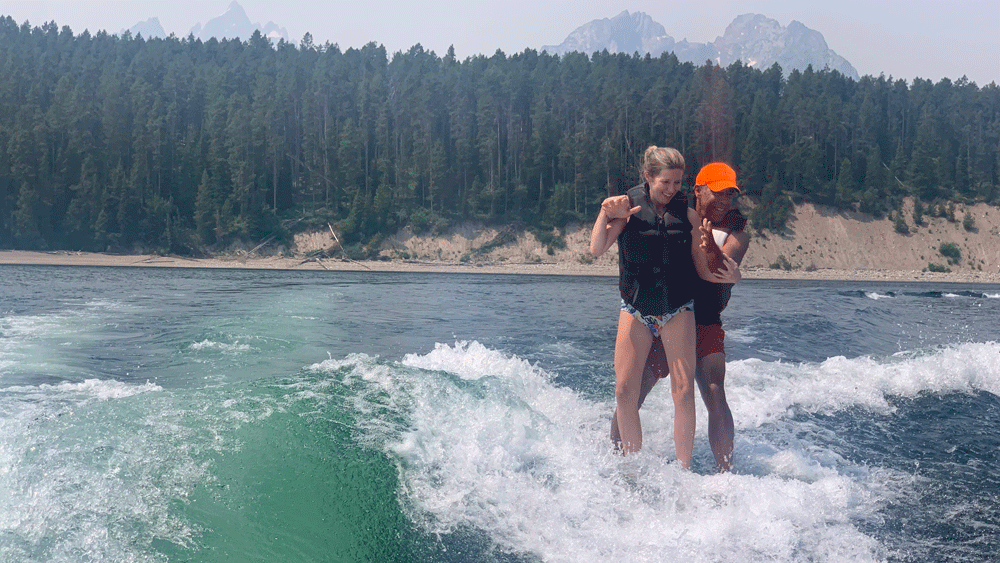
The author wake surfing on Jackson Lake
Panerai
We returned in good spirits at another one of Chin’s favorite spots, on the rooftop of Coelette in downtown Jackson, for a family-style dinner. A big screen played out photos from the day’s excursions—both from the wake surfing and climbing groups. The smiles and outstretched arms and legs of the climbing group did not belie what I was about to experience the following day. The group was also instructed not to divulge any details to those of us that went wake surfing. I leaned back in my chair and casually observed clients discussing their watch collections (one client owned upwards of 60 Panerais), ordering expensive off-menu wine and boasting about the latest Ferrari addition to their fleet of vehicles. One collector, who had flown in on his private jet for the experience, dined with his Pomeranian on his lap. This did not seem like a crowd that was used to getting their hands dirty (in any sense).
However, a fit-looking client seated next to me quietly clued me in to what lay ahead. “Let me tell you, it was a lot harder than I expected,” he whispered. “My arms are so scratched up under my shirt that it stung like fire when I took a shower.” I felt a wave of concern wash over me, but I wasn’t too worried since I was scheduled to climb with the zero-experience group. ‘Surely, they will give us an easier route,’ I thought while scanning the room in search of other visible injuries.
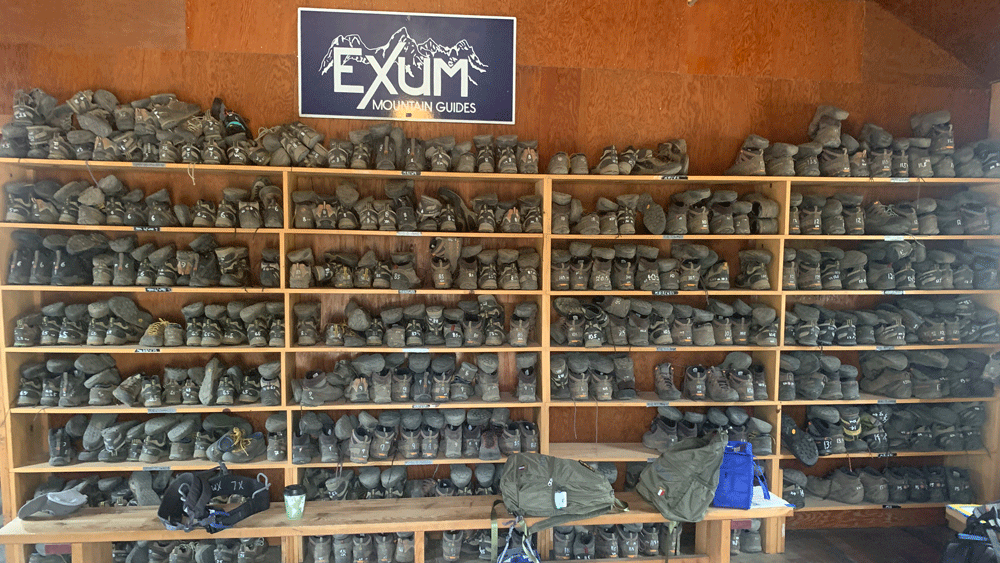
Exum Mountain Guides Outpost
Paige Reddinger
The next morning, group 2 awoke early for the ride to the Exum headquarters—employer of some of the best mountain guides in Wyoming—which was a 10-minute boat ride from the entrance to the Grand Teton National Park. It felt poignantly serene as we glided across Jenny Lake and then did a short hike past a cascading waterfall to an area with small boulders where Jimmy and his five-person mountain guide team, including world-class alpinists Michael Gardner and Adam Fabrikant, would begin to show us the ropes.
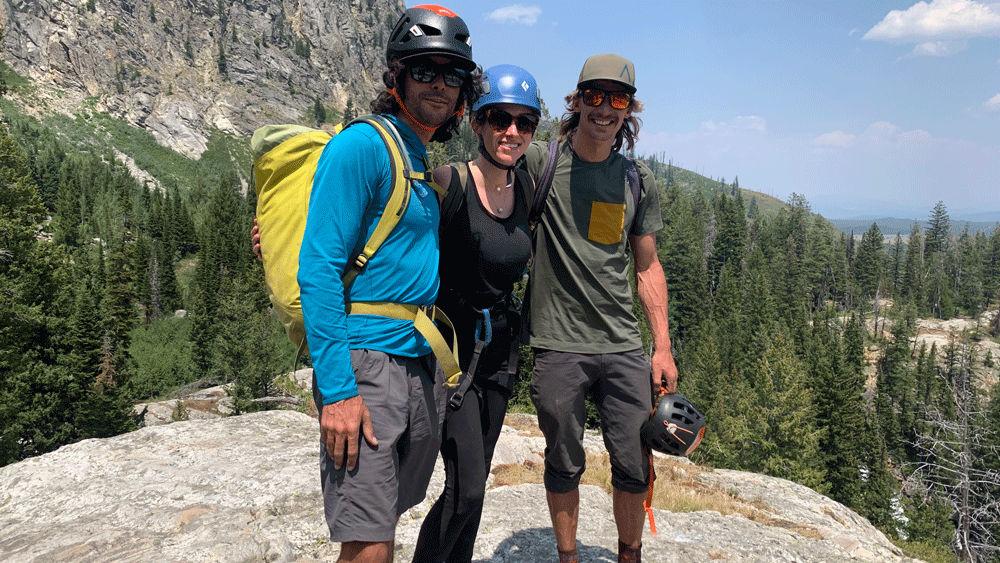
From left: Adam Fabrikant, the author and Michael Gardner
Paige Reddinger
We would spend the next hour and a half learning how to climb on the “easy” rocks. What we didn’t know was that Chin & Co. were quietly assessing our skills in order to divide us into groups based on what we would be capable of on the mountain. “I can tell how a person is going to climb based on how they walk coming across a parking lot,” said Gardner.
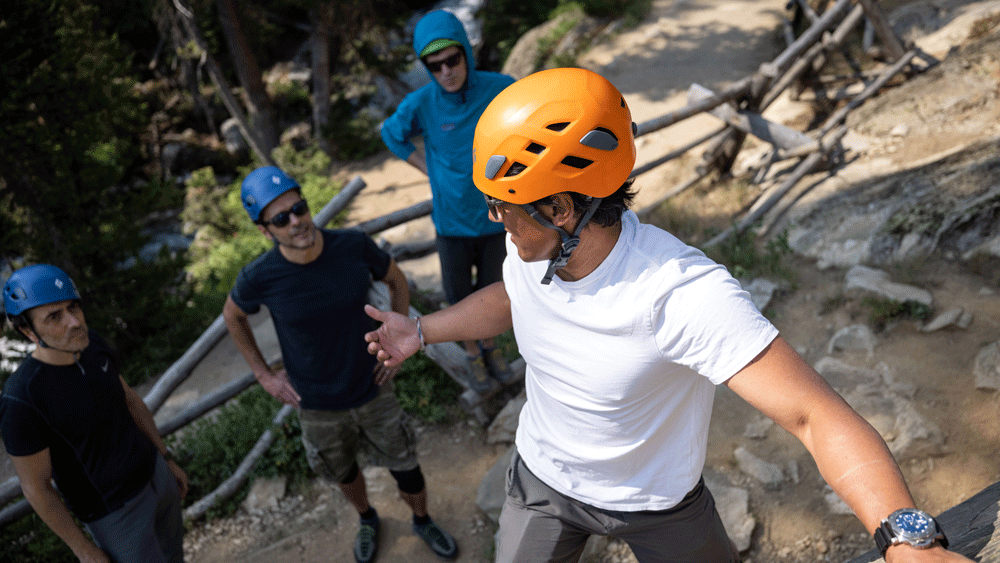
Jimmy Chin showing clients the ropes
Dirk Collins
Surely, I thought, they could see that I am better equipped at pounding the pavement of New York City’s concrete jungle than scaling a cliff in the wilderness akin to the size of a Manhattan skyscraper. But I felt my heart start to pound as soon as my group reached the base of the mountain. Anything above the base, I soon found out, should be called “the point of no return.”
I was third in line to ascend in a group of four and as I made it a quarter of the way up the first pitch I began to experience something the pro-climbers refer to as Elvis leg. I was all shook up. My right leg wouldn’t stop shaking. I had to get it together. I desperately needed to move on in order to avoid falling. It’s quite amazing to realize what you are capable of when you feel you are in a life or death situation (even though I was perfectly safe in their hands). So, on I went as I used what felt like every muscle in my body to continue upwards. I fell three times before I made it to the top where I used all the strength I had left to fling myself over a jagged slab of rock like a whale flopping over a jetty.
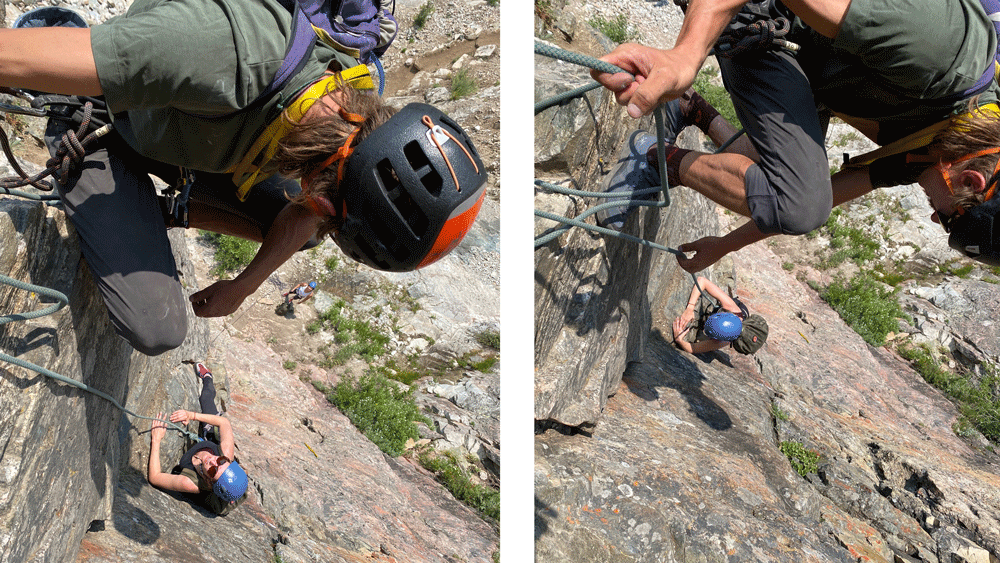
Climbing the mountain with Exum’s Michael Gardner as a guide
Panerai
As I sat there collapsed and shaking in the dirt, on a small ledge the size of what felt like my desk seat, I looked over to see some dried blood on the rock from previous climbers—not exactly the kind of thing that calms one’s nerves. I clung to the side of the mountain like a newborn clutching a mother’s breast. Recognizing just how far I had pushed my fear of heights and that I might be about to lose it, Chin came over, grabbed my hands and with a soothing voice began doing a breathing exercise with me for what felt like a solid five minutes. (If he wasn’t one of the world’s best extreme climbers, he would make an excellent therapist.) As my panic began to subside, he asked if I wanted to go back down. I didn’t hesitate. I had reached my limit.
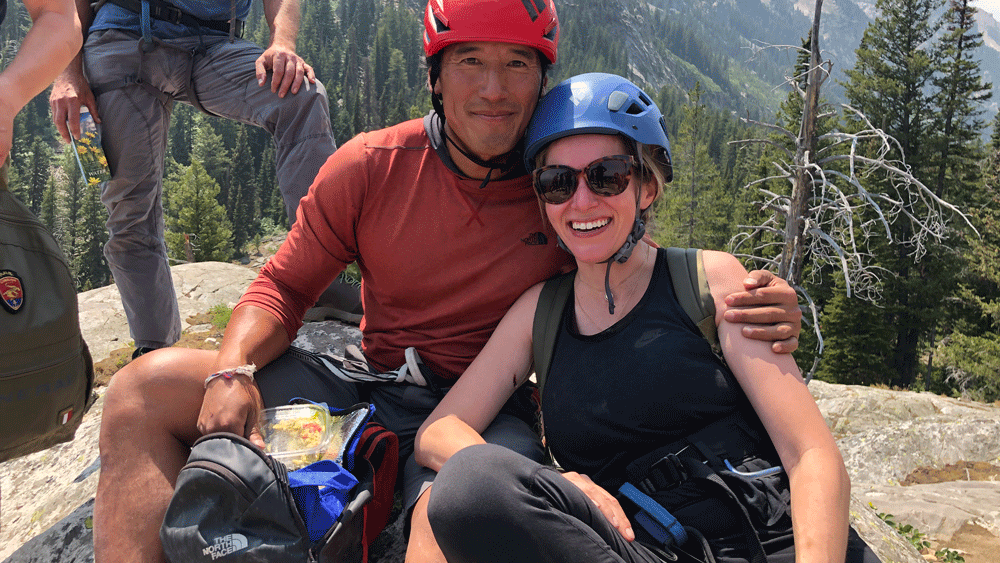
The author with mountaineer Jimmy Chin
Panerai
“You just climbed the hardest pitch on the whole trip!” said Chin. I thought, ‘What on earth made these guys think I could do this?’ But I did do it. For me, making it up just the first pitch (200 feet) was a huge accomplishment. By the time I got back to the hotel room, I was covered in bruises and had a gash in my arm that looked like the mountain had taken a bite out of me. (When I returned home my fiancé joked that my legs were so bruised I looked like I had painted camouflage onto my legs. The next day he told me my arm looked like it was covered in moss.) I look back and can hardly believe it was me that made it up that mountain. I feel transformed and capable of way more than I ever thought was possible. I also took home some mementos—a small red scar in the shape of a smiley face—and a memory that will last a lifetime. If you ask me, it was worth it.
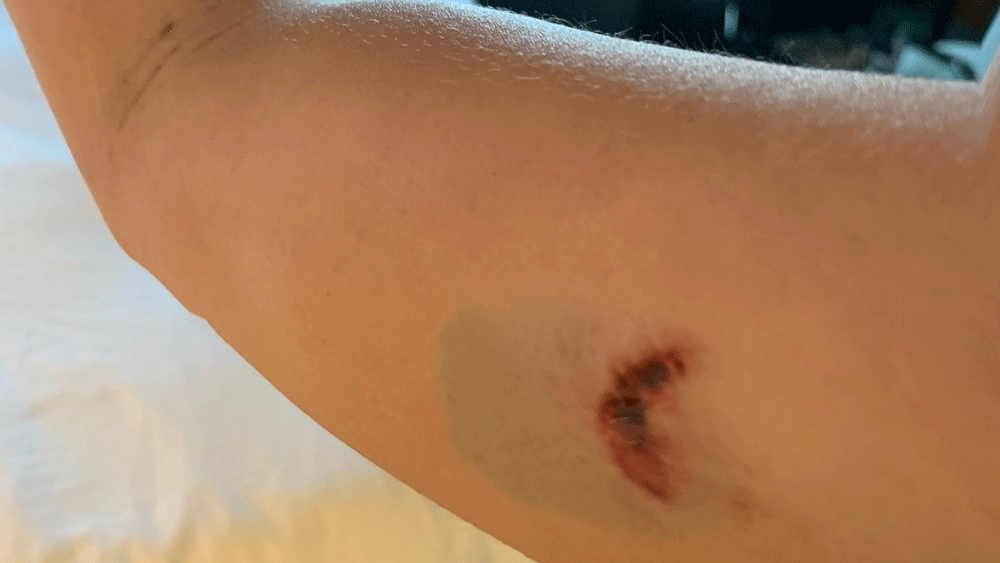
The author’s battle wound
Paige Reddinger
Beyond my own personal experience, one truth remained clear for all: Everyone is equal on the mountain. The VIPs who bought into the trip are all high-achievers who have reached a certain pinnacle of success in business. They all have the wealth to create this experience on their own, but the journey is in the comradery of the shared experience. Material bragging rights fly out the window in the face of the harsh physical realities of the wilderness.
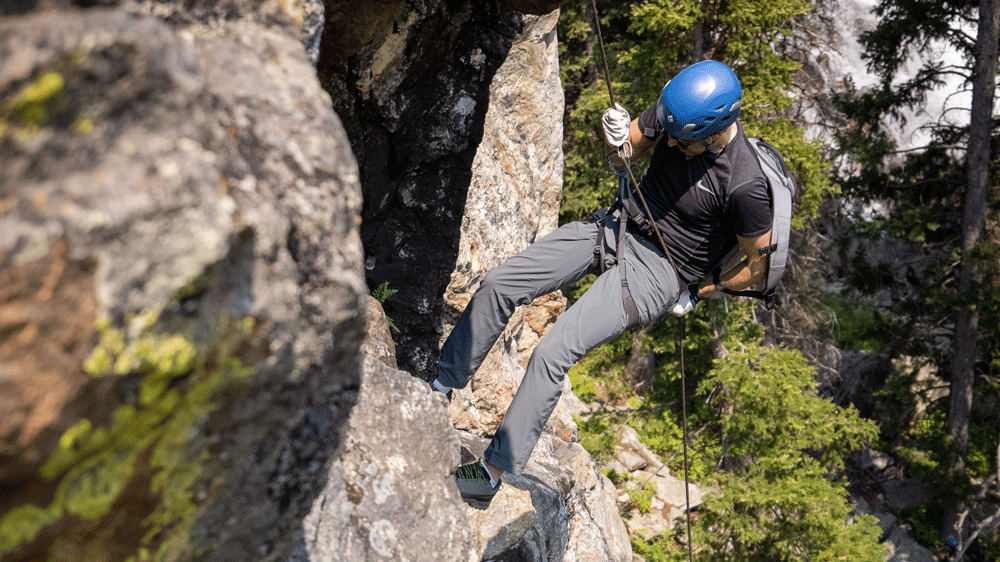
A Panerai client on the mountain
Dirk Collins
And, as it turns out, it’s not an experience that sheer net worth can buy. According to Bonay, Panerai takes a very active part in selecting clients for its trips. “We had a lot of inquiries but we went to customers,” he said. “We knew that one element was a certain level of fitness. We also picked guys that were also going to get along.” From a legal standpoint (many release forms were signed), it’s also no small undertaking. After the last group returned from climbing, Bonay had a huge grin and exhaled a sigh of relief knowing that everyone had returned safely. “It’s a big risk for a brand to do something like this,” added Chin. “There are a thousand and one ways for this to go sideways and not be authentic or be cheesy or over-the-top and pretentious. This isn’t that. We’re out to have a real experience and we want people to walk away with new friendships and relationships. It is not easy for a brand to pull that off. And I know, because I work with a lot of brands. But it’s worked because I think the strength of this brand and what it represents is drawing these people together.”
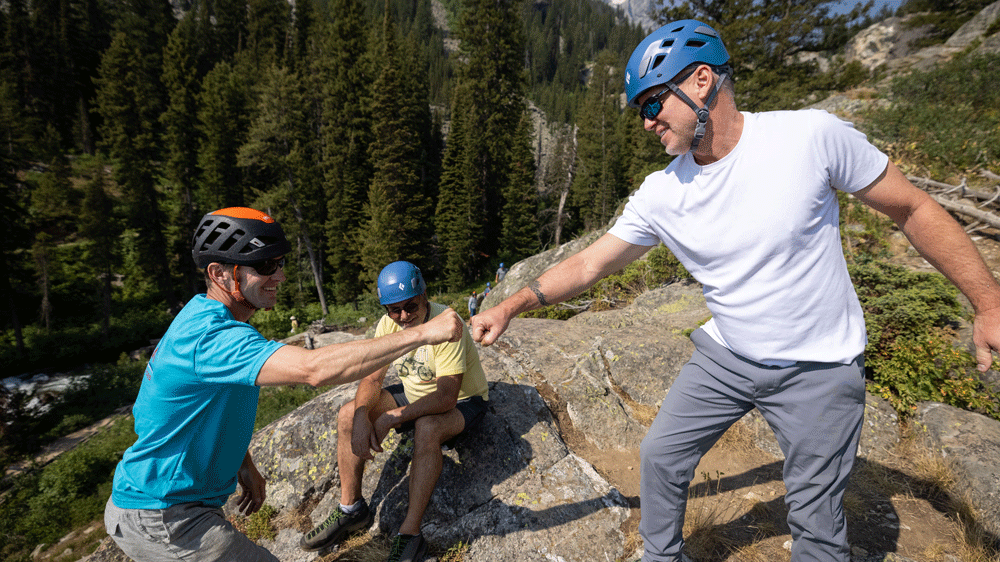
Panerai clients bonding on the mountain
Dirk Collins
So, what was the selling point for the collectors? The watch or the experience?
Jimmy Ngo, a supplement manufacturer based in Orange County, CA:
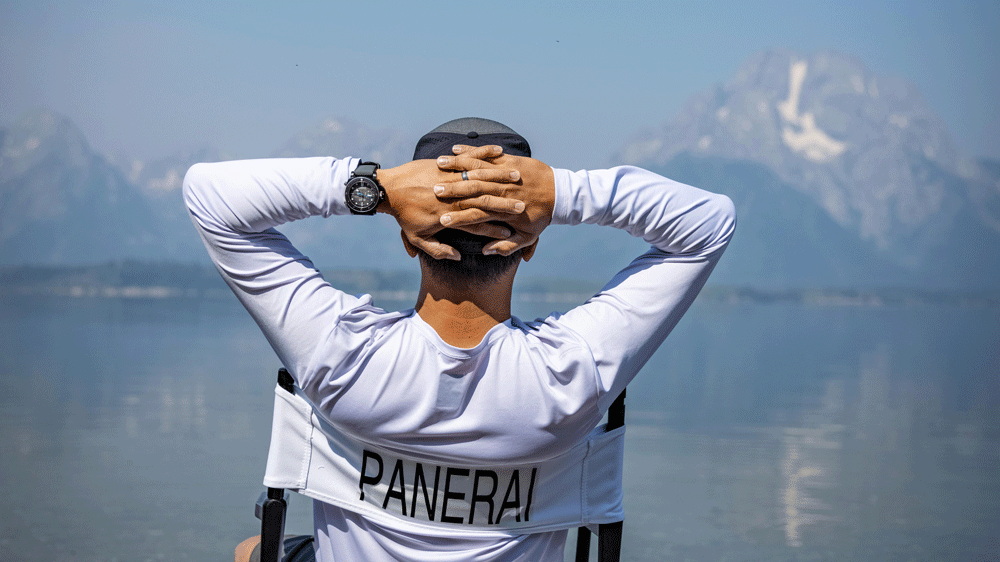
O2A2040-BrittMumma
BrittMumma
“The watch, definitely. I saw the presentation about four hours after it went live to all the different stores. I literally got the email at 10:30 in the morning and I went to the store at 2:00. There was a 15-page Power Point presentation talking about Jimmy Chin and the collaboration. They showed the experience watch first and I was like, ‘That’s the one I want.’ I love the colors and everything pops a lot more. Stan, at the store, said, ‘You know you have to do the experience in order to buy it right?’ I said, ‘Ok, sure. I like the watch. I want it.’ He told me, ‘You know you have to be fit.’ I said, ‘Whatever, I’ll do it.’ [Laughs] Then I had to convince my wife. It’s post-pandemic and we haven’t gone anywhere and I’m saying I want to buy this watch and go on a trip that I can’t take her on. Fortunately, she said, ‘That’s great. You should go. It’s a once in a lifetime thing.’”
Louis Paster, a Chicago-based managing director of bond portfolios for UBS:
I bought the watch because I like my dealers and I have a lot of brands from them like IWC or A. Lange & Söhne. But when they called me up about this watch, I first said no. And then after they showed it to me I said, ‘Ok, fine.’ I know who Jimmy Chin is and I thought it was cool they invited me. I have a lot of Panerais that are hard to replace. I bought the watch because it was one of 14, but it’s not replacing my tourbillon. The dial is unique and I didn’t have a DLC-coated case before.
It was a meaningful experience that mattered to me in my own head. I dug that. I honestly always think I can do more. That’s how my head works. I felt like I was more just really amazed as my perception changed about what was happening and what we were doing. Initially, it looked really easy and then as I did it I was like, ‘Holy shit! This is fucking crazy!’ I knew I was safe, but when I had to do the crack climb, this spot where I had to put my hand in the cracks and keep pushing, I was thinking about how I walk on my legs every day but my arms are what deal. I loved the staff and the team and all the contractors. The vast majority of people I met, I will maintain a relationship with hopefully.
Nimesh Davé, a Newport, California-based executive of a high-tech cloud computing company:
“It’s the experience for me. Every time you look at the watch, you get to reflect on the memories of the event. And the event was fantastic. What I find surprising is that I have since talked to every single person that was on that trip. I’m already seeing one person tomorrow in Vegas. So, I think the watch is just the token memory. I look at it more as a souvenir. How often do you get to do something like that? I told the guys in the boutique, ‘Look, I’ll do anything. If it’s a little bit off the beaten path and a little more crazy, count me in.’ As soon as Mike Horn came out, I signed up and I signed up for this one the day it came out. I think this is something they have an amazing concept around.
I’m big into climbing and I had Alex Honnold out at one of my conferences just before Free Solo won the Academy Award. That’s when I really got into the climbing thing.”
Could you have just done the experience on your own with Honnold or Chin?
“Yeah, probably but you get to meet other people with common interests. The people there are watch obsessed and you end up with a group of common characteristics, which is kind of interesting because everybody there was of the kind of personality that pushes themselves further. They pushed themselves pretty hard too. That was no joke.”
Yannick (last name redacted), a California-based technology executive
“For me it was both. The watch mattered. When they came to me and told me about the experience I was mostly in, but I told them I still want to see the watch. I wouldn’t buy the experience if I didn’t want the watch. But Jimmy was a big part of it though. I had seen Free Solo and Meru. I’ve seen Free Solo twice and it’s one of those things even when you know the ending, you’re still scared. Jimmy is very special and he made the whole thing. You could tell he cared and he was putting himself into it. He was orchestrating it like he would orchestrate a movie.”
Jason (last name redacted), a North Carolina-based owner of a custom truck company:
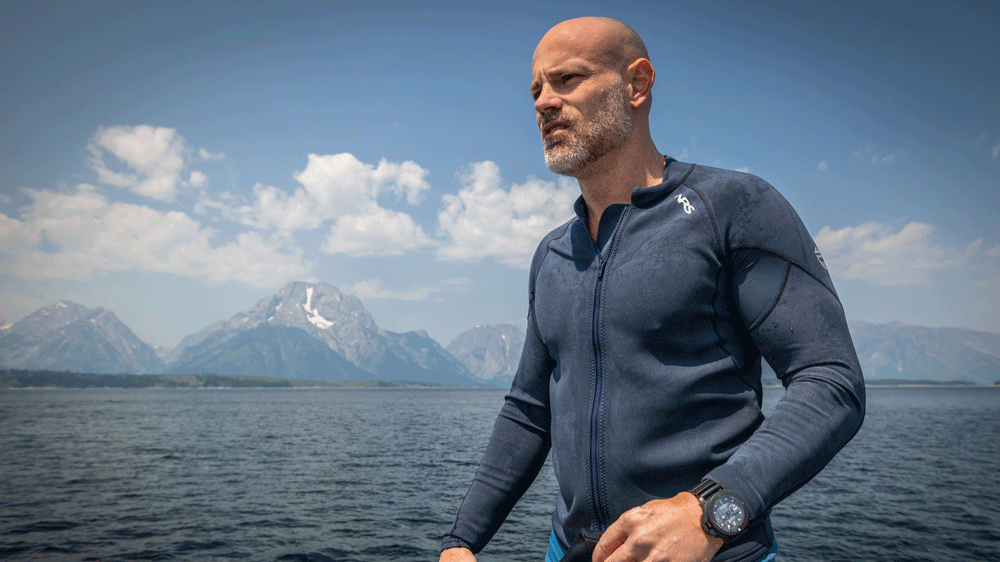
Panerai Client, Jason, and the new Xperience watch
BrittMumma
“For me, it was definitely the watch. The experience was just an added benefit. I buy something because I like it, not what’s attached to it. That for me, goes for anything in life. I would have still bought the watch even without the trip. But the experience that Panerai has offered has been mind-blowing.”
